
J. Ross Baughman
[Editor’s Note: Photojournalist J. Ross Baughman emailed me the following excerpts from his autobiography in response to my recent post on critical response to Bob Dylan’s paintings derived from photographs. Baughman’s narrative of his involvement with the painter Leon Golub doesn’t address Dylan’s work, yet pertains because it describes a consensual, mutually respectful, and creatively fruitful relationship between a painter and a photographer ― the exception, alas, not the norm. I commend it to painters and other graphic artists as exemplifying a responsible relationship to any photographer’s work. And I thank Ross for granting me permission to convert this into a Guest Post, complete with the accompanying illustrations. — A. D. C.]
•
Allan,
I very much enjoyed your latest column on “The Photographer and the Painting (part 1),” and look forward to studying the rest of it. Following your long career has always been a challenge. As a matter of fact, our paths crossed briefly while we both taught at The New School during the early Eighties.
In that light, I offer this excerpt from my forthcoming autobiography, “Angle.” It touches (abstractly) on some of the points you raised about Dylan’s paintings, but then takes off in a few other surprising directions. At the very end, I have also attached four images that relate to this tale.
•
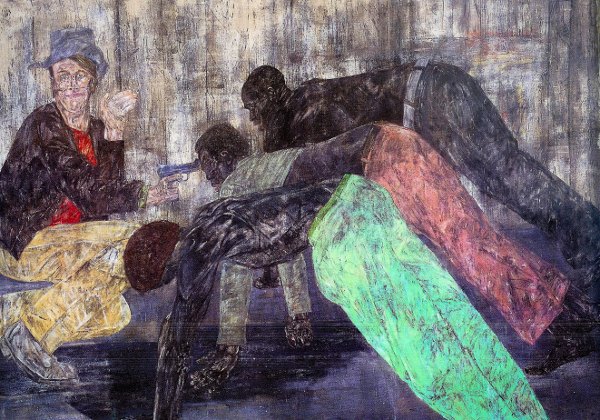
Leon Golub. “Mercenaries V,” painting, 1984. Copyright © 1984 by Leon Golub.
When he referred to this painting by Leon Golub [“Mercenaries V”], the art critic Robert Hughes wrote [in 1984] for TIME magazine, “It sets one’s teeth on edge … the sense of the picture, against the massive but hopelessly vulnerable arches of his victims’ backs, with an awful precision. In the end, there are some tasks that painting can do and photography cannot. No camera is allowed in the basements of power that Golub has made peculiarly his own.”
Perhaps he might have asked the artist for more background.
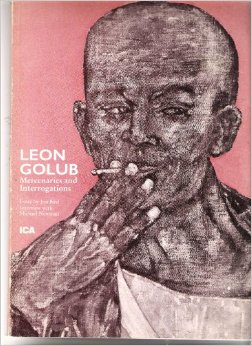
“Leon Golub: Mercenaries and Interrogations,” exhibition catalogue (1982), cover.
Not long before, I had read a review and then visited a gallery in Manhattan giving a solo show to Golub’s work. I felt so moved by the pictures drawn from his imagination — pictures of mercenaries, death squads and their victims — that I returned the next day with a letter and the gift of a print. I felt an overwhelming sense of communication with this painter, even though we had never met, because the things I had seen with my own eyes were exactly what had been filling his mind’s eye.
When Golub phoned me, and asked if he could base a painting on what I had seen, I was more than pleased and refused the thought of taking any money for my input. We have even discussed a series of future paintings that will make permanent a few memories of mine that I missed getting onto film. It may become a bit like a witness being quizzed by a police sketch artist, except we will be trying for something much more than a mug shot.
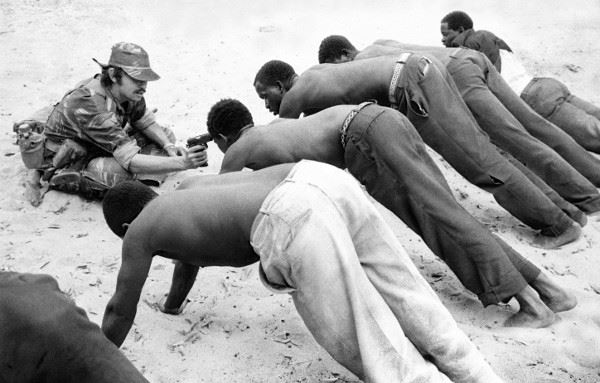
J. Ross Baughman, “Interrogation,” 1977. Copyright © 1977 by J. Ross Baughman.
When the Rutgers University Press published a monumental monograph of the artist’s work a few weeks after the TIME profile appeared, Golub wrote, “Baughman left this photo at my exhibition at the Caldwell Gallery. While I ordinarily do not compose so directly from photos, in this instance the image was so strongly defined that I was impelled to ‘appropriate’ it.” In other writings, Golub went on to thank the photographer “to whom I owe a lot” and for being “really influential in the recent work” and “a further collaboration.” This recent work, in Golub’s intention, assembles “the face of the modern world, a composite portrait constructed from bits of photographic data.”
But it is so much more than a portrait. The answer to issues raised by Hughes is clear. Photography can do the work. And photojournalists are the right people for the job.
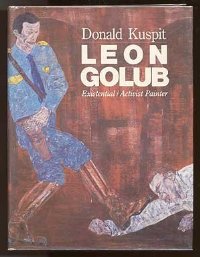
Donald Kuspit, “Leon Golub” (1985), cover.
But what exactly was Hughes getting at? People with a taste for art, who so often direct the assignments, the look and the final choices for much of the visual communication in print these days, have come to think of photography in very limited terms. Much of what they use, and about all they encourage from their photographers on assignment, are faces, little more than nouns made into icons. Their love of typography has reached an all-time high. Many of the special packages they make for front pages, section fronts, magazine covers and double-page spreads turn to art work or studio still-lifes. Sometimes photographs get really tiny.
But I don’t blame them.
We’re going through an extended period where editors don’t seem to think that photojournalism deserves bigger play. But I think a stronger case can be made. Icons can make for a very arresting display in print. When people read about a person, it’s an honest curiosity to want to see the face to go with the name. Many stories are locked into past events that we have already missed, or are keyed into abstract concepts like time, scale and economy that don’t call out for an eyewitness.
But sooner or later, great photojournalists will stop settling on portraiture, preparing themselves ahead of time with higher ambitions. As professionals, we will still have to do a good job on the requests that are handed to us, but by thinking things through, making lots of cold phone calls to strangers, asking lots of questions, we will be more and more often able to put our finger on the essence of a story, ahead of time. We should be able to anticipate events, budget and schedule our time wisely and compete with our own work, offer the same subjects, still beautifully seen, but in the midst of narrative action.
Set a more challenging standard. Activate the icons, activate them in such a way so that we see the heart of the issue, the essence. As a viewer, I like pictures that say loud and clear how the subjects feel. For me, the best pictures are essential, diagrammatic, active, argumentative, narrative, pure projections of at least one of the subjects’ points-of-view …
•
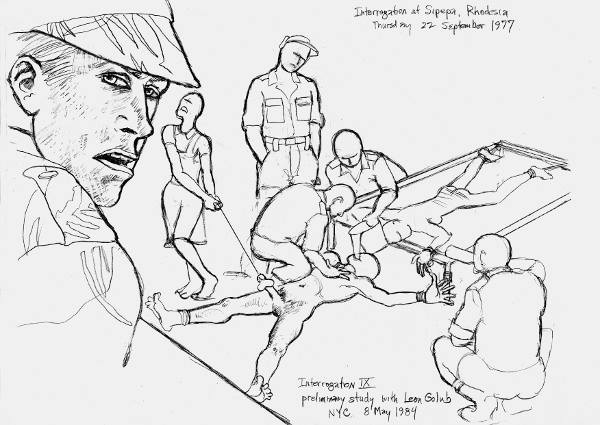
Leon, Golub, study for “Interrogation IX,” 1984. Copyright © 1984 by Leon Golub.
Leon Golub’s huge, mural-sized painting, the one based on my Rhodesian interrogation photo, seems to take on a life of its own. It is bought before the paint is even dry by Charles Saatchi, an Iraqi-British advertising magnate; and in Manhattan’s fine art world, that alone stirs up plenty of attention. Beside his reputation in the media, Saatchi is equally well-known for the size of his art collection, along with his deep pockets and impeccable taste.
Then a PBS documentary film on Golub premieres at Lincoln Center, and it features his progress on the work from start to finish, including a glimpse or two of what inspired him.
True to his earlier promise, Leon and I spend a couple of afternoons making sketches for a future project based on the torture of Moffat Ncube, one that he tentatively plans to call “Interrogation IX.” Leon likes to assault his viewers with a hint of complicity, drawing them into the scene on a par with evil. What he wants to show most is the moment that I am warned, “You’ll be next.” That becomes the nickname we have for it.
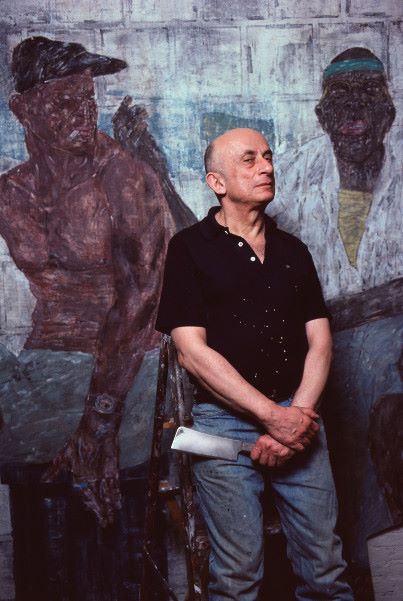
J. Ross Baughman, “Leon Golub, 1988.” Copyright © 1988 by J. Ross_Baughman.
Then, quite separately from knowing anything about my involvement, the editors at Vanity Fair decide to write a profile about Leon. When they ask about sending a photographer to his studio for a portrait, he insists that it will have to be me. That kind of “special request/demand/extortion” from a story subject often rubs editors the wrong way, but no arm-twisting is needed this time. My old colleague from LIFE magazine, David Friend, has become one of their top editors and Elisabeth Biondi runs the photo department. She had been the deputy to Alice Rose George back at GEO magazine during its brief existence, and then for a few years at Stern magazine in Hamburg. We have had a great rapport ever since those days, and once even shared a sixteen-hour flight from New York to China where we nearly stayed awake the whole way, lost in conversation.
Best wishes,
Ross
•
Baughman’s autobiography, “Angle,” will be published later this year by Amazon.
The Robert Hughes review referred to appeared as “The Human Clay in Extremis,” TIME, 31 December 1984, p. 67.
The Rutgers University Press monograph referred to is Leon Golub: Existential/Activist Painter, with text by Donald Kuspit (1985).
The documentary referred to is Golub, a film by Kartemquin Films, Chicago, IL, 1988 (previewed at the New York Film Festival, 1988).
Text by J. Ross Baughman copyright © 2013 by J. Ross Baughman. All rights reserved. Reprinted by permission.
Captions for images:
- “Mercenaries V,” by Leon Golub, 1984. Copyright © 1984 by Leon Golub.
- Leon Golub: Mercenaries and Interrogations, exhibition catalogue (1982), cover. The show toured under the auspices of the Institute of Contemporary Arts, London, UK.
- Trooper Graham holds guerrilla prisoners in the mid-day heat during a two-week search-and-destroy mission near Rhodesia’s border with Botswana, 22 September 1977. The photo, entitled “Interrogation,” is part of a portfolio that won J. Ross Baughman the 1978 Pulitzer Prize in Journalism for Feature Photography. Copyright © 1984 by J. Ross Baughman.
- Kuspit, Donald, Leon Golub: Existential/Activist Painter (Rutgers, NJ: Rutgers University Press, 1985).
- A preliminary sketch for Interrogation X made as a collaboration between Golub and Baughman, based on the three-day torture of Moffat Ncube, a black nationalist politician in Rhodesia.Baughman witnessed the brutal treatment but was stopped from photographing it. Golub never completed the painting. Copyright © 1984 by Leon Golub.
- Leon Golub holds one of his trademark artist’s tools, a meat cleaver, in front of a large mural, “4 Blacks,” during the making of a portrait for Vanity Fair magazine by J. Ross Baughman, March 1988. Copyright © 1988 by J. Ross Baughman.
•

J. Ross Baughman
In 1978, at the age of 23, photojournalist J. Ross Baughman became the youngest professional ever awarded the Pulitzer Prize, and was cited for his coverage of the guerrilla war in southern Africa.
While continuing to work that same year as the first contract photojournalist ever hired by the Associated Press, he competed against himself with two other nominations: For infiltrating the American Nazi movement over nine months to uncover their assassination and bombing plans and once more for being the first journalist to ever accompany Palestinian commandos operating behind Israeli lines.
Baughman soon went on to become an international lecturer on journalism ethics, a university professor and founder of the photo agency Visions, which specialized in long-term, high-risk, difficult-access investigative photo essays around the world. Besides covering wars in 11 countries, his work has appeared everywhere from LIFE to Vanity Fair, Newsweek, Time, Stern, The New York Times Magazine and Vogue.
Some of his writings and photographs may be seen at Wikipedia and at his own website. To contact J. Ross Baughman, click here.
•
For an index of links to all posts related to this story, click here.
•
This post supported by a donation from the Estate of Lyle Bongé.






Leave a Comment